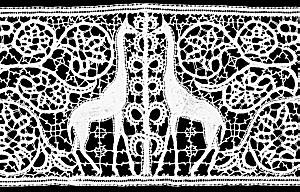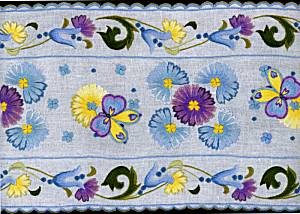
Sansepolcro lace

Mannocci needle painting
| ANNE WANNER'S Textiles in History / book reviews, articles |
| Merletti e Ricami
italiani - Italian Laces and Embroideries, edited
by Christina Notore, Essays by Thessy Schoenholzer
Nichols, Marialuisa Rizzini, Bianca Rosa Bellomo, Bologna
April 2005, text in Italian and in English, 192 pages,
161 pictures: illustrated in colour and black and white,
ISBN 8889262060
|
| This book
accompanies the second edition of Italia invita - the
international Forum of Lace and Embroidery, a
biennial event dedicated to this important aspect of
Italy's cultural heritage, an opportunity for
embroiderers and lacemakers to meet and to display and
discuss their works. As a contribution to the understanding past and present developments in these areas, this publication includes research into various techniques - this research formed the core topic of the Exhihition "Le Origini" (Origins) and the fundamental theme of the 2005 Italien Invita forum. This is the first volume of a series of historical and educational publications that the Association plans to produce, thus launching the Italia Invita Colleciton. |
The theme for this
exhibition of Italia Invita is "Origins"
- a study of lace and embroidery based on traditional
techniques in the 16th century; these have been
resurrected since the end of the 19th century and are
popular hobbies in Italy today. To maintain a manageable focus, embroidery made with gold and silver thread as well as modern embroidery for fashion, theatrical and ecclesiastic use have been excluded for the purposes of this study. This initial work includes only the lace and embroidery stitches of a specific period; this will have to be expanded in the future, when works from the following centuries will be analysed as well, thus hopefully contributing to further our study and understanding of these textile masterworks. |
| Thessy Schoenholzer not only proposes groups and comparisons of lace and embroideries, but she also gives drawings and a glossary of stitches in context found in the "Origins": from the middle-ages to the beginning of the 17th century, in embroidery and lace and still in use in Italy |
 Sansepolcro lace |
|
| Contents: - Laces and embroideries from the 16th century and from today, a proposal of groups and comparison by Thessy Schoenholzer Nichols - The Origins: studies on lace works and embroideries based on pattern books from the 15th and the early 16th centuries - Borders: Italian techniques, as
still in use today: - "I would like to be understood without speaking ..." Laces, embroideries and pattern books in the 16th century by Marialuisa Rizzini - Elisa Ricci: Embroideries and
pattern books in the 16th century - List of exhibitors |
| home content | Last revised July 16, 2005 | For further information contact Anne Wanner wanner@datacomm.ch |